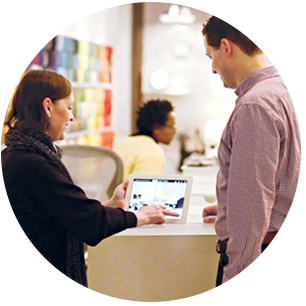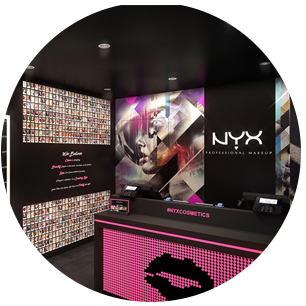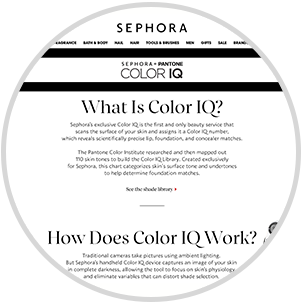The day-to-day life of the modern store associate is more demanding than ever. In the past, employees were tasked with stocking shelves, assisting customers and completing transactions at the cash wrap. But as retailers build out their omnichannel operations and engagement strategies, associates’ to-do lists and necessary skill sets are growing dramatically.

of retailers say they plan to invest in training and additional staff over the next year.
- A.T. Kearney
“The evolving role of the store has changed how customers and brands expect how store associates interact with them,” said Adam Pressman, Partner in the Retail and Digital Transformation practices, A.T. Kearney. “No longer is putting items on shelves enough. Associates are expected to effectively engage with customers, while also completing a variety of tasks.”
In fact, results from the A.T. Kearney Achieving Excellence in Retail Operations study concluded that consumers say “experience” and “service” have the most profound impact on their in-store shopping journeys.
“No longer is putting items on shelves enough. Associates are expected to effectively engage with customers, while also completing a variety of tasks.”
- Adam Pressman, A.T. Kearney
To meet consumer expectations, retailers are striving to onboard a workforce that can connect with customers on a “sincere and personal level, understand their needs, and have a desire to use the full range of technology available in the store to ensure that the client walks out of that store with merchandise either in hand or in transit,” noted Jerry Sheldon, VP of Technology at IHL Consulting Services. “Employers realize the need to hire someone with the diligence of a Boy Scout, and the interpersonal skills and emotional IQ of someone that participates in the drama club at school.”
After all, store associates are the face of the retail brand, noted Russ Ronchi, Co-Founder of Formula 3 Group. “They’re literally the first face someone encounters when they walk in your store.”

Associates are the face of retail brands.
Are you empowering your associates to engage with shoppers and serve them well?
However, retailers are encountering a predicament: While they’re in dire need of friendly, skilled and tech-savvy employees, the average turnover rate in retail remains especially high, according to Ken Morris, Principal at Boston Retail Partners.
“There is an increased number of available retail positions and a reduction in the number of people interested in them,” Morris said in an interview with Retail TouchPoints. “To acquire and engage the right employees, retailers need to invest in tools, technologies and learning tactics that empower their workforce and make them feel more connected to the brand.”
This special report uncovers how retailers can capitalize on the power of their people by:
Top Technologies Improving Associate Experiences
The once linear shopping journey has turned into a zigzagged path consisting of myriad information sources. As a result, the role of the associate has changed dramatically.
“Consumers have more information at their fingertips, so sales associates are used in a completely different manner,” said Victoria Brown, Senior Research Manager for IDC Retail Insights. “There are still requests for other sizes or to see if an item is available elsewhere, but online shopping has changed much of this.”
Store associates now have three very different roles and information requirements, according to Brown:

Product Expert

Fulfillment or Materials Handler

Interaction & Experience Coordinator
Some of the top technologies and applications designed to augment the in-store experience for associates and shoppers include:
True Religion Augments Clienteling With Mobile And Wearable Tech
True Religion has achieved a new level of omnichannel excellence by combining digital signage with mobile POS, an associate-facing Apple Watch app, CRM and robust clienteling capabilities.
First launched in December 2015, the True Religion “Band” app was designed to integrate with Aptos Mobile Store Point of Sale and Aptos Enterprise Order Management. Created in partnership with Formula 3 Group, the app allows associates to “flick” product images from the watch to a large digital signage screen. This keeps shoppers engaged, despite True Religion’s traditionally small store formats, by giving them in-depth views of product images and styles. When a shopper is ready to make a purchase, store associates can complete the transaction on a tablet device.
With the addition of Aptos CRM and Clienteling, the updated app arms associates with more detailed customer information. This “closet” of data shows product images, past purchases, average order value, lifetime value and social media feedback. Employees can use all back-end information to facilitate a highly personalized experience.
Click here to learn more about the True Religion experience, or watch this video featuring John Hazen, SVP of Direct to Consumer & Omnichannel for True Religion.
Education And Enablement Imperatives: Think Visual And Interactive
Up to 60% of retailers are struggling to execute and measure the ROI of technology investments, according to the A.T. Kearney Achieving Excellence in Retail Operations study. To ensure new technology meets customer and corporate expectations, 75% of retailers say they plan to invest in training and additional staff over the next year.
Industry analysts spotlighted the training and engagement tactics they believe are most effective:
Video: “YouTube videos are one of the most effective training tools,” Morris of Boston Retail Partners said. “They can be accessed from anywhere you have Internet access and the combination of audio and visual is the clearest way to communicate new processes.”
Pressman of A.T. Kearney added that the explosion of YouTube, Netflix and other consumer-facing video channels validates the growing importance of video. Retailers need to explore video “as a way of communicating and sharing information with their employees.”
Rewards and incentives: “To me, it comes back to incentives for performance with today’s workforce,” Sheldon of IHL said. “If that reward is money, okay, but if the reward is an experience, even better. Zumiez is doing some really innovative, creative and effective things in this area. It is a young, hip and cool brand and when they reward employees for meeting goals, they bring their top performers together for a training event wrapped in a party.”
While educational courses, quizzes, videos and rewards programs help employees stay up-to-date with new practices and technologies, sometimes the most powerful influencer is a monetary reward. Despite their shifts to omnichannel engagement and fulfillment, many retailers have not adjusted the ways they measure employee success and productivity, which has negatively impacted employee engagement and loyalty.
5 Tips For Forging Associate Engagement And Relationships
Retailers need to take a hard look at their employee engagement, training and empowerment strategies to ensure that they’re cultivating the culture and work lifestyle that star-quality employees crave. Our industry experts offer a series of best practices to guide the way:
A New Equation For Associate Productivity And Profitability
Who do you credit for omnichannel sales?
Take Retail TouchPoints’ 2016 Store Operations Survey to share your feedback!
Consumers’ omnichannel shopping behaviors have made measurement more complex. Today, retailers need to be able to measure the lifetime value of customers, which requires knowing them and understanding their behaviors across all channels. Retailers need to be able to track when and how a store associate played a role in the shopping journey, and whether that associate impacted the final buying decision — regardless of whether a purchase took place in a store or online.
“If your systems can’t talk to each other, you’re in for a rough ride,” Ronchi noted. “Understanding your data touch points and how to make it all flow together is what leads to successfully measuring productivity and success.”
55% of retailers do not offer employees incentives for fulfilling omnichannel orders
- Boston Retail Partners
Many retailers (55%) also do not offer employees incentives for fulfilling omnichannel orders, according to the 2016 Customer Experience/Unified Commerce Survey from Boston Retail Partners. Other rewards vary:
- Offering partial sales credit or commission for orders fulfilled from a store (27%);
- Having dedicated employees handle fulfillment (16%);
- Adjusting store labor costs/credits to compensate for orders fulfilled from a store (16%);
- Providing incentives or bonuses to pull inventory and fulfill orders promptly (7%); and
- Rewarding associates with complete credit for a sale (2%).

“Understanding your data touch points and how to make it all flow together is what leads to successfully measuring productivity and success.”
- Russ Ronchi, Formula 3 Group
Morris added: “When retailers fail to motivate and compensate sales associates, they risk lackluster adoption of processes at the floor level, and subpar customer experiences.”
Focusing solely on sales generated by each associate also negates the personal element of associate-to-shopper conversations, according to Brown. “Maybe an associate spent time with a customer helping them with a custom look for an upcoming event and they only purchased one item, but later on down the line they think of that great experience, and return to the store to buy more because they know they will have quality interactions.”
To ensure they’re recognizing and rewarding employees effectively, retailers will need to take these factors and overall task completion into account and refine their incentives accordingly.
Culture: The Backbone Of Engaged Brand Communities

Millennials are the least engaged of the modern workforce.
Just as consumers expect better experiences from the brands they buy from, employees expect the same from the businesses they work for. However, research from Gallup shows that only 32% of the modern workforce is engaged, with 51% not engaged and 18% disengaged. Millennials are the least engaged (29%) of all age groups.
Members of the modern workforce want to join a thriving corporate community and feel fulfilled in their professional lives. Retailers need to further invest in creating this empowering and satisfying environment so they can hold on to their best employees.
“In the pursuit of omnichannel excellence, the store associate has been largely ignored,” Pressman said. “Creating a positive working environment and investing in helping them to be successful are critical to engaging the modern workforce. Smaller brands like Warby Parker and Bonobos provide great examples of how brands are setting clear brand standards and are seeking employees who share those beliefs and values.”
Questions? Send us an email at
info@retailtouchpoints.com.
Copyright © 2016 Retail TouchPoints.
All Rights Reserved.












